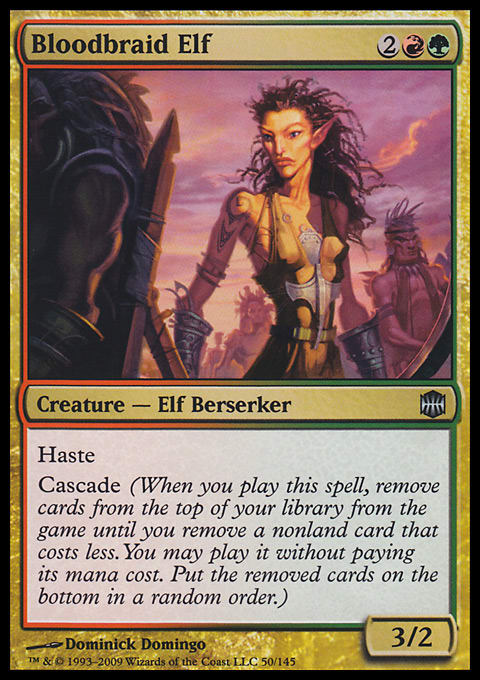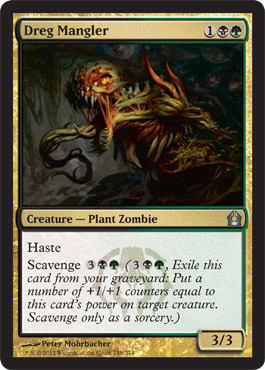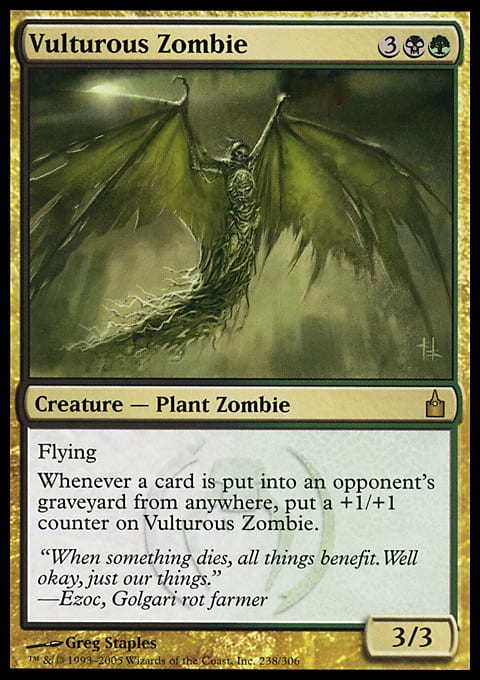Creature type is one part of a Magic: The Gathering card that doesn’t receive a lot of notice. How often do you really think about it? Sure, there are cards such as Cavern of Souls and War Falcon that require an awareness of creature type, as well as the occasional Commander theme deck, but otherwise many players pay it scant attention. Creature types do a couple really valuable things for Magic. First, along with the card name, art, statistics, and flavor text, they paint a picture of the creature and how it interacts with its world. This is especially helpful when a card is so awesome or complicated that there is no room for flavor text. Knowing that Bloodbraid Elf is an Elf Berserker, for example, gives you some information about her despite the fact that the cascade ability hogs up most of the card real estate.
Creature type also helps players form a connection between Magic and other fantasy and science fiction worlds, such as those in other games, movies, and books. This helps new players more quickly relate to Magic and the multiverse in which it is set. One might look at Kessig Cagebreakers, see that he is a Human Rogue, and draw a parallel to one of the quintessential rogues of humanity: Han Solo. That’s a useful starting point for visualizing these guys breaking fierce beasts out of confinement.
One of the first things I noticed about Magic cards when I started playing was the similarity between creature types and races, classes, and monsters of Dungeons & Dragons, a game with which I was very familiar. I can rely on my past gaming experiences to better flavor what a Human Wizard, Troll Cleric, Ogre Shaman, or Goblin Warrior might be up to in the many worlds of Magic.
There are over two hundred creature type components in Magic, including Advisor, Dragon, Knight, and Zombie. These components are mixed together in different and interesting combinations. Competitive Standard players frequently battle by summoning Human Scouts, Elephant Soldiers, Elf Shamans, and Human Wizards for example. More types enter the game with each expansion. One of my favorite things about the Gatecrash spoilers so far is the interesting creature types affiliated with the green- and blue-colored, nature-loving guild of Ravnica: the Simic Combine.
In this article, I’ll examine the flavor of these new Simic creature types as well as a couple other creature types of Magic’s past, and I’ll finish up with a look at the most numerous creature types in the game of Magic.
Mutants, Hybrids, & Experiments
The Simic Combine is the environmentalist group of Ravnica. Their goal is to preserve and protect the few remaining wild places in a land with unending urban sprawl. The only type of wildlife that can survive in such a world is that which can adapt to it, and the Simic use their magic to morph existing creatures into new hybrids and mutants that can do just that. Here are some examples both fish and fowl.
 |
 |
Evolve, the Simic keyword in Gatecrash, is fitting for these creatures—both have gone through some rapid evolution at the hands of the Combine. The Cloudfin Raptor has developed long, kite-like wings that catch the rising heat common to any metropolis or downright gusty world like Ravnica. They can soar for hours and even days far above the city, making them ideal scouts for the Simic. They are also ideally suited to ferry landlocked creatures around Jezeru, the partially submerged Lake District of Ravnica.
The Elusive Krasis feels most at home in this section of the city, frequently acting as guards and sentries. These Fish Mutants also have a more secret role thanks to the Crypsis Clade, the Simic project team focused on things such as camouflage and secrecy. The Crypsis have tinkered with certain Krasis to make them tough to spot or stop.
Then there are the hybrids, combinations of two or more creatures.
 |
 |
There is really only one reason to cross a Crocodile and a Frog: defense. A super-strong tongue that can lash around another creature and pull it into those massive jaws makes the Crocanura well-suited to defend its spot in the ecosystem. The Shambleshark has a similar purpose. It is very quick like a skittering crab and able to appear as if from nowhere. Adding the vicious temperament and predatory instincts of a shark, without the aquatic limitations, gives the Simic another weapon to keep urban sprawl at bay.
Finally, Gatecrash gives us a glimpse into Simic’s experiments on humanity.

The Hull Clade, the Simic team focused on protection, defense, and durability, has a little-known project to create indestructible flesh. Rather than try to make it impenetrable, the Hull went the opposite direction, and Experiment One is the result. It is unknown whether the patient was a volunteer or forcefully procured by the Simic—what is known is that Experiment One is a successful proof of concept. He is nearly impervious to punctures and piercings and is able to heal over time from wounds caused by bludgeoning and slashing weapons.
Type History
Gatecrash is just the latest Magic expansion to add new and interesting creature types to the game. The history of Magic is littered with other interesting examples. There are five hundred forty-four one-of-a-kind creature type combinations, including:- Bear Illusion – Phantasmal Bear
- Fungus Shaman – Ghave, Guru of Spores
- Pest – Signal Pest
- Squirrel Beast – Krosan Beast
There are many interesting creature types with only a handful of representatives. We have the faith-fueled and change-driven Human Rebel Clerics . . .
. . . as well as the rare, brave, and valiant Goblin Knights . . .. . . and—last, but certainly not least—the stuff of legends, Elder Dragons.
Let’s take a deeper look at a couple creature types of the undead variety.
Plant Zombies
Plant Zombie conjures an image for me of a dead forest: trees devoid of foliage, short, thin branches sticking straight out like spikes, larger branches broken and hanging loose, no birds perched on their limbs, no squirrels running up and down their trunk, entirely devoid of life. Until you look closer, of course. Then, they creak to life and shift toward you with the groan and crack of rotting wood and attempt to grab you with their broken branch limbs and pull you into those spikes.
There’s certainly potential for undead foliage, and Magic has made the most of it, primarily in the land of Ravnica. Ravnica: City of Guilds was home to three Plant-based undead, and Return to Ravnica included another pair, all belonging to the black and green Golgari Swarm. The Golgari Swarm is dedicated to a certain balance between life and death. The Swarm would be keen to renew growth and life in the above dead forest, but also hastening decay in areas of overabundance.
Zombies straddle this line between life and death well, and as such, they suit the Golgari purpose well. They are mostly floral and fungal aberrations constructed and controlled by the necromantic powers of the Lotleth. The Lotleth faction is a faction of undead tasked with serving as the frontline labor in the constant efforts to expand the influence of the Swarm and reclaim lost areas.
The Plant Zombies of the Lotleth have a number of roles:
- Shambling Shell’s best asset is its expendability. It can be used as spare parts to repair other, more valuable Zombies, and it can be quickly repaired by any material close to hand.
- Woodwraith Strangler is more cannon fodder. This uprooted undead can be thrown against the enemies of the Swarm with little regard. It is able to come back again and again by absorbing the decomposing flesh of the dead.
- Slitherhead is the simplest of constructs for the Golgari to create: nest vines in the skull of one of the many dead of Ravnica. Its role is twofold: a minion to slow down enemies and fertilizer for the heartier Golgari.
- Dreg Mangler is grown and animated in areas the Golgari wish to secure and is well-suited for fighting off foreign foes. Even after defeat, this Plant Zombie serves the cause, nourishing its replacement and strengthening the cause.
- Vulturous Zombie is made of tightly woven plant fibers animated and granted flight through necromancy. Like a vulture, it grows stronger by feeding on the dead and decay around it.
Zombie Mercenary Assassin
Speaking of Zombies, there are four Zombie Mercenaries: Phyrexian Driver, Phyrexian Prowler, Spineless Thug, and Spiteful Bully.
And there are four Zombie Assassins: Stronghold Assassin, Tsabo's Assassin, Unliving Psychopath, and Zombie Assassin.
But there is only one Zombie Mercenary Assassin.
You’ll note that only one of these words appears on the card; however, Zombie and Assassin were added later as part of the Grand Creature Type Update: Wizards of the Coast’s mass modernization of pre-Mirrodin-block cards to the current creature-type model. With the decaying face, I could see why they decided to go with Zombie, but I have some concerns. There seems to be not one but two contradictions in these three words.
Let’s start with Zombie-plus-Assassin. I view Zombies as shambling husks of humanity that are probably dragging a mangled foot, moaning and groaning as they pursue their soon-to-be-victim. Zombies should be slow-moving menaces that one can easily outrun but had best not be surrounded by. This is the traditional type and is used to great effect in The Walking Dead television series, to cite a more recent example. There is a much newer breed of zombie in popular culture. These are the fast-moving, acrobatic, Olympic-athlete-style undead seen in movies like 28 Days Later and the 2004 version of Dawn of the Dead. For a zombie to be an assassin, it would certainly have to be this second type.
Let’s assume that Rathi Assassin is this second type—she certainly looks spry enough—and move on to the second contradiction: Zombie-plus-Mercenary. I picture a zombie as an instinct-driven, brain-consuming machine fueled by a ceaseless desire to dine upon the living. A mercenary, in contrast, joins one side or another of a conflict for private gain—usually money. A key problem with a zombie mercenary, I would think, is the negotiation process:
Employer: “In return for your assassination-related services, I am prepared to pay you . . . ”
Zombie Mercenary: Grabs employer; “Braaaaaaiiiiiinsss…” CHOMP!
Employer: “AAAAAAHHHHH, MY ARM; IT’S EATING MY ARM! GET IT OFF! GET IT OFF! THIS PAIN IS THE WORST EVER!!!”
Not your typical salary negotiation, but hey, I’ll give her the benefit of the doubt here. The second ability on her card suggests she has some people skills and experience in recruiting like-minded individuals. It would be tough to recruit fellow Mercenaries if you had a tendency to view them all as snacks. Perhaps there is just enough cerebral activity here for this Zombie to tamp down her undead urges. Maybe she has developed a taste for harder-to-acquire Elven brains, a delicacy only certain individuals with means can easily acquire. Rathi Assassin might be just wise enough to spare such an employer and offer her services in return for a steady supply.
Creature Type Data
To close out the article, let’s move from flavor to facts. I did some number crunching of the one thousand forty-nine unique creature type combinations in Magic: The Gathering. Here are the creature types that appear on the most cards in Magic history. Each card with multiple printings—Serra Angel, for example—is only counted once.

Spirits just narrowly edge out Human Wizards thanks to the tribal attention of the Innistrad block. Fear not, Human tribal fans; Humans are by far the most populous single type in Magic. Four of the top eight combinations and 21% of all creature cards include Human in the creature type.
I hope you enjoyed this look at creature types new, old, unique, numerous, and Zombie. I’d love to know what creature types you like or find interesting. Let me know in the comments or on Twitter. Thanks for reading!
Nick Vigabool




























